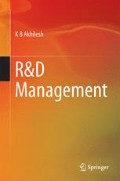Abstract
Human resource (HR) management investigates the strategic role of individuals, groups, structure, and organization in planning, development and management of R&D. Managing human resources is complex, diverse, and interdependent. This chapter explains what human resource management is and how it relates to R&D management by emphasizing the role of engineers, scientists, and professionals among R&D personnel. The next section of this chapter focuses on how R&D manager can use HR concepts, tools, and techniques like human resource planning, inventories, demands, performance appraisal, staffing plan, career planning, and development. At the end of this chapter, we have emphasized the role of career planning in two levels, that is, individual-centered and organization-centered career planning. Further, we have given a brief review on career planning tools which will be a key guide to R&D HR managers.
Learning Objectives: To characterize the terms engineer and scientist, and also understand their professional features in R&D; to explore the link among staffing plan, recruitment plan, and development plan with career plans of the scientists and engineers in human resource planning and development system; to describe various aspects in career planning and people management.
Access this chapter
Tax calculation will be finalised at checkout
Purchases are for personal use only
References
Badawy MK (1971) Industrial scientists and engineers: motivational style differences. Calif Manage Rev 14(1):11–16
Cattell RB (1965) The scientific analysis of personality. Penguin, Harmondsworth
Driver MJ (1985) Demographic and societal factors affecting the linear career crisis. Can J Adm Sci 2(2):245–263
Flanagan JC (1954) The critical incident technique. Psychol Bull 51(4):327–358. doi:10.1037/h0061470
Herzberg F, Mausner B, Snyderman B (1959) The motivation to work. Wiley, New York
Hower RM, Orth CD (1963) Managers and scientists: some human problems in industrial research organizations. Division of Research, Graduate School of Business Administration, Harvard University.
Kerr S, Von Glinow MA, Schriesheim J (1977) Issues in the study of “professionals” in organizations: the case of scientists and engineers. Organ Behav Hum Perform 18(2):329–345
Marcson S (1960) The scientist in American industry: some organizational determinants in manpower utilization (no. 99). Published in cooperation with the Industrial Relations Section, Department of Economics, Princeton University, by Harper
Taylor CW, Smith WR, Ghiselin B, Ellison R (1961) Explorations in the measurement and prediction of contributions of one sample of scientists. Utah Univ, Salt Lake
Author information
Authors and Affiliations
Rights and permissions
Copyright information
© 2014 Springer India
About this chapter
Cite this chapter
Akhilesh, K.B. (2014). Human Resource Management in R&D. In: R&D Management. Springer, New Delhi. https://doi.org/10.1007/978-81-322-1946-0_9
Download citation
DOI: https://doi.org/10.1007/978-81-322-1946-0_9
Published:
Publisher Name: Springer, New Delhi
Print ISBN: 978-81-322-1945-3
Online ISBN: 978-81-322-1946-0
eBook Packages: Business and EconomicsBusiness and Management (R0)

